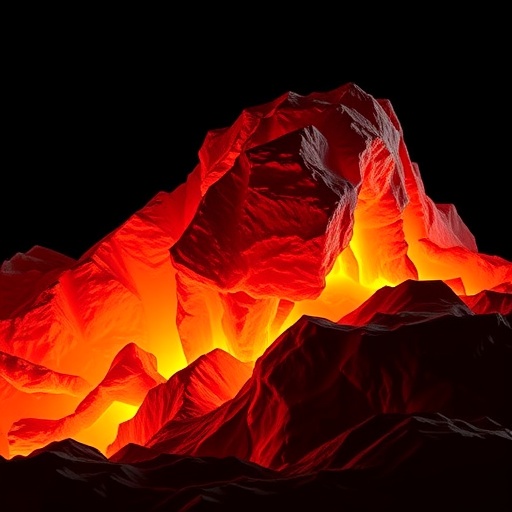In a groundbreaking study poised to reshape our understanding of volcanic processes, an international team of scientists has harnessed cutting-edge X-ray ptychography to resolve the elusive three-dimensional architecture of nanolites—ultrafine crystals that form within magma during volcanic eruptions. This pioneering work, published in Nature Communications, reveals that the rapid formation of nanolites not only alters magma’s internal structure but also significantly influences its rheological behavior, with profound implications for eruption dynamics and hazard forecasting.
Volcanic eruptions, mesmerizing yet devastating natural phenomena, emerge from complex interactions within molten rock beneath the Earth’s crust. Traditionally, research has focused on larger crystals forming in magma, but the smallest crystalline entities, nanolites, have evaded detailed scrutiny due to their nanoscale dimensions and rapid formation timescales. Previous methods lacked the resolution to capture these tiny yet critically important features in three dimensions, until now.
By utilizing X-ray ptychography, a revolutionary imaging technique that exploits coherent diffraction patterns to reconstruct ultra-high-resolution three-dimensional images, the research team succeeded in visualizing nanolites at unprecedented spatial resolution. This approach enabled the scientists to quantify nanolite morphology, distribution, and network connectivity within natural volcanic samples, providing concrete evidence that nanolites influence magma properties during the eruption itself, rather than solely during cooling.
The significance of nanolites in volcanic materials lies in their ability to affect magma viscosity through their volume fraction and spatial arrangement. Higher viscosity magma resists flow, potentially leading to increased pressure buildup and explosive eruptions. Prior models underestimated the rapidity and extent to which syn-eruptive nanocrystallization can modify viscosity, thus underappreciating the dynamic feedback mechanisms that govern volcanic activity.
This research demonstrates that nanolites nucleate and grow dynamically as magma ascends and depressurizes, forming complex interlocking networks. Such networks increase the effective viscosity, or flow resistance, of magma on timescales shorter than previously thought possible. The implications for eruption forecasting are substantial: better predictive models can be developed that incorporate real-time rheological changes induced by nanolite formation, improving hazard assessments.
Beyond volcanic science, the methodological advancements reported here open new frontiers for the study of nanoscale crystallization processes in geological materials. The ability to perform non-destructive, high-resolution, three-dimensional imaging of nanostructures represents a powerful new tool for geoscientists probing the physical and chemical evolution of Earth materials under extreme conditions.
The interdisciplinary collaboration spanned geoscientists, physicists, and material scientists, leveraging state-of-the-art synchrotron facilities capable of producing coherent X-rays necessary for ptychographic imaging. This synergy was critical in overcoming long-standing technical challenges associated with imaging non-crystalline or weakly crystalline materials embedded within complex matrices, such as volcanic glass hosting nanolites.
One of the key findings is the direct correlation between nanolite morphology and magma rheology: prismatic nanolites that form intertwined networks enhance effective magma viscosity more than equant or isolated crystals. This morphologic specificity offers insights into how crystal shape and spatial organization govern macroscopic flow behavior, an aspect previously obscured by 2D imaging methods or bulk rheological measurements.
The study also highlights the temporal evolution of nanolite populations during syn-eruptive crystallization. Real-time measurements indicate that nanolite nucleation is triggered within minutes to hours as magma undergoes rapid decompression and cooling during ascent. This swift crystallization process contrasts starkly with slower magmatic cooling models and demands reconsideration of the timelines applied in volcanic monitoring.
Furthermore, the research underscores the importance of integrating nanoscale data into larger-scale volcanic models. By contrasting rheological changes inferred from nanolite development with observable eruption styles—ranging from effusive lava flows to devastating explosive events—the team connects microscopic processes to global volcanic behavior, creating a more holistic understanding of eruption physics.
These findings also carry potential for applied volcanology, including the design of real-time monitoring protocols that detect precursor signals indicative of rapid nanolite crystallization. Such signals might manifest as changes in magma viscosity, degassing patterns, or seismic signatures, all measurable by advanced remote sensing and in situ instruments deployed around active volcanoes worldwide.
The novelty of this work lies not only in resolving an outstanding geological mystery but also in showcasing how innovation in imaging technology can lead to paradigm shifts in earth science. X-ray ptychography emerges as a versatile probe capable of tackling longstanding questions about nanocrystalline materials embedded in complex geological settings—a capability with broad ramifications beyond volcanology.
As the planet faces variable volcanic hazards in densely populated regions, improving predictability and understanding eruption mechanisms remains a priority. This study stands at the forefront of efforts to bridge scales from atomic to tectonic processes, inspiring further research into how minute crystallization events ripple outward to influence the Earth’s dynamic systems.
In summary, the elucidation of nanolite-related rheological changes via three-dimensional X-ray ptychography marks a decisive leap forward in volcanology. By capturing the rapid, syn-eruptive nanocrystallization phenomena affecting magma flow, scientists unlock new insights into volcanic eruption dynamics, offering promising avenues for improved hazard mitigation and fundamental earth science.
The future of this research avenue involves applying these imaging techniques to a broader array of volcanic samples, spanning composition, eruption style, and tectonic setting. Extending the temporal resolution to capture nanolite formation in situ during eruptions could revolutionize our ability to forecast and understand volcanic behavior globally.
Ultimately, this work epitomizes the power of interdisciplinary science and technological innovation in unveiling the hidden processes shaping our planet. The ripple effects of these discoveries will inform not only those living in the shadow of volcanoes but also the fundamental understanding of crystalline matter formation under extreme natural conditions.
Subject of Research:
The study investigates the formation and three-dimensional quantification of nanolites in magma using X-ray ptychography, focusing on how syn-eruptive nanocrystallization impacts magma rheology and eruption dynamics.
Article Title:
3D quantification of nanolites using X-ray ptychography reveals syn-eruptive nanocrystallisation impacts magma rheology
Article References:
Bamber, E.C., Arzilli, F., Cipiccia, S. et al. 3D quantification of nanolites using X-ray ptychography reveals syn-eruptive nanocrystallisation impacts magma rheology. Nat Commun 16, 7083 (2025). https://doi.org/10.1038/s41467-025-62444-z
Image Credits:
AI Generated




